'Nothing's Shocking,' 35 years on: How Jane's Addiction's studio debut revolutionized rock 'n' roll
Mike McCready, who declares the 1988 LP “one of the greatest records ever," recalls that pre-Pearl Jam band Green River "opened up for Jane’s Addiction… and they broke up the next day because Jane’s Addiction was so good! For that reason — they were like, 'We’re never gonna get this good, so let’s do something else.'"
Nirvana and Nevermind usually get most of the credit for pounding the grungy nail in hair metal’s spandex-lined coffin. But it was a band of artsy L.A. street urchins, Jane’s Addiction — frontman Perry Farrell (who always fulfilled the promise of his name, “peri-pheral,” fearlessly dwelling on the lunatic fringes of L.A. rock ’n’ roll), guitarist Dave Navarro, drummer Stephen Perkins, and bassist Eric Avery — that broke major pre-grunge ground. By artfully mixing heavy metal thunder, jam-band jungle boogie, and pi?ata-smashing punk-funk into a cacophony of (Tijuana) biblical proportions, against all odds Jane’s Addiction orchestrated a seismic shift beneath the Sunset Strip’s asphalt — becoming the unlikely hottest draw in an ’80s Hollywood scene otherwise overrun by bubbleglam bands with misspelled monikers like Tuff and Lixx Array.
The rest of the alternative nation took notice after the release of Jane’s debut studio effort, Nothing’s Shocking, released 35 years ago on Aug. 23, 1988. With its grotesque and Walmart-unfriendly cover art, ocean-sized guitar bombast, chilling lyrics about serial killers and parental neglect, and disturbing incantations like “sex is violent” (a line that Nirvanabes Bush later seemingly interpolated), it was a druggy death-rock masterwork that no doubt influenced the Seattle scene as well as Hollywood’s.
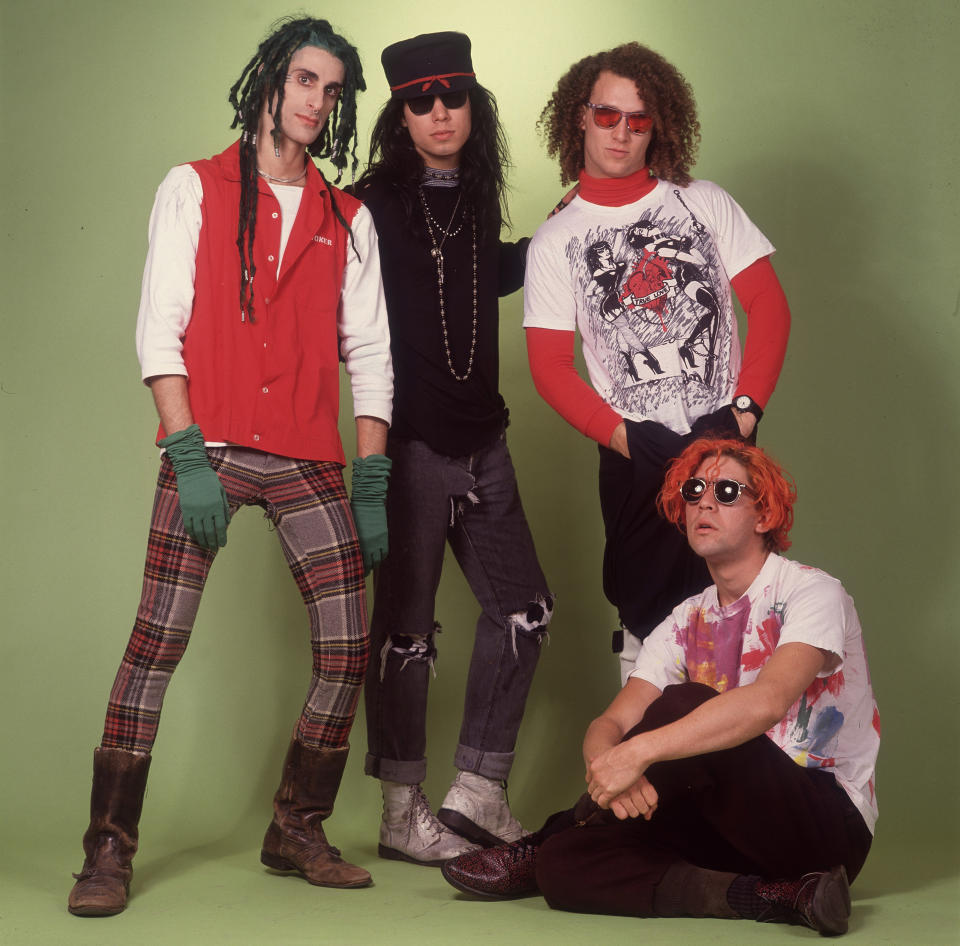
Pearl Jam guitarist Mike McCready, who calls Nothing’s Shocking “one of the greatest records ever,” even laughs, “Green River [Stone Gossard and Jeff Ament’s pre-Pearl Jam band] opened up for Jane’s Addiction at [Los Angeles club] Scream, and they broke up the next day because Jane’s Addiction was so good! For that reason — they were like, ‘We’re never gonna get this good, so let’s do something else.’ There’s a huge influence there.”
“What we were doing at the time, we didn’t think we were necessarily doing some great, original thing,” Navarro says humbly, reflecting on the early Jane’s days. “If there was any element of trying to make it that way, it would have bled through and been apparent. But the fact was we were just doing what we were doing, because at that time a band like us wasn’t going to get a lot of traction. So, we were like, ‘F*** it, let’s just do what we do.’ And then that’s what people caught on to.”
Jane’s Addiction formed in 1985, at a time when hair metal bands like Poison and Faster Pussycat were the Strip’s main (or mane) attractions — but the band members’ musical backgrounds extended far beyond that. “I think that we all had different influences, so when we got together to write or record, those influences sometimes clashed, and then again, sometimes they worked really well. In the cases where they worked, we would go with it, and in the cases where it clashed, we would find a way to work around it,” says Navarro, the self-described “metal kid” of the group, who joined in 1986, at age 19, after the band had gone through several other guitarists who hadn’t gelled. “It gave us the opportunity to have some really unique ideas creatively among the four of us. Perry had just done a Goth record, Eric was really interested in Joy Division, and Stephen and I had more of a heavy metal background. We creatively clashed but in a really beautiful way.”
Understandably, Jane’s appealed to people both within and outside the L.A. metal scene who were hungry for something dangerous and different. “We had a community of fans; they were from all walks of life. They all had different T-shirts,” Navarro explains. “One guy would have a Guns N’ Roses T-shirt on. Another guy would have a Fear T-shirt. One guy would have a Flock of Seagulls T-shirt. Another guy would have a Bad Brains T-shirt. We got Deadheads out there. We just attracted a very unique group of fans that were interested in lyrical content and were interested in musicianship.”
And so, Jane’s Addiction found themselves at the center of an exciting underground scene alongside like-minded outsider artists. “Back in those days, that’s when I first met Flea and Anthony [from the Red Hot Chili Peppers], because we were all just kind of these weird misfits that were in this scene that included guys like Thelonious Monster and Fishbone and some of these post-punk bands. We had a little circle of people, where we all know we’re the outcasts, but with each other, we’re all the coolest. You know what I mean? I miss that kind of in-the-trenches stuff from the early days,” says Navarro.
Red Hot Chili Peppers drummer Chad Smith, who moved to L.A. from Michigan the same month Nothing’s Shocking came out and joined RHCP a few months later — and later played with Navarro in the Peppers lineup from 1994 to 1998 — recalls being blown away when he first shared a bill with Jane’s.
“[Perry] looked like an alien that was super high, kind of scary, but at the same time just kind of floating. And I was like, ‘This is something else. I’ve never seen anybody like this before in my life!’ And they go on to play — and they were scary to me! They scared me,” says Smith. “They were so powerful, and they looked weird. Everything about it was just so unique. … The whole thing was just so incredible, and I was like, ‘Now I really get it. … This is what it’s about. This is dangerous, powerful, mystical.’ They looked like junkies, and they had a drummer back there who looked like [the Muppets’] Animal; Perkins was shaking his big hair, playing these tribal Bonham beats. I will never forget it.”
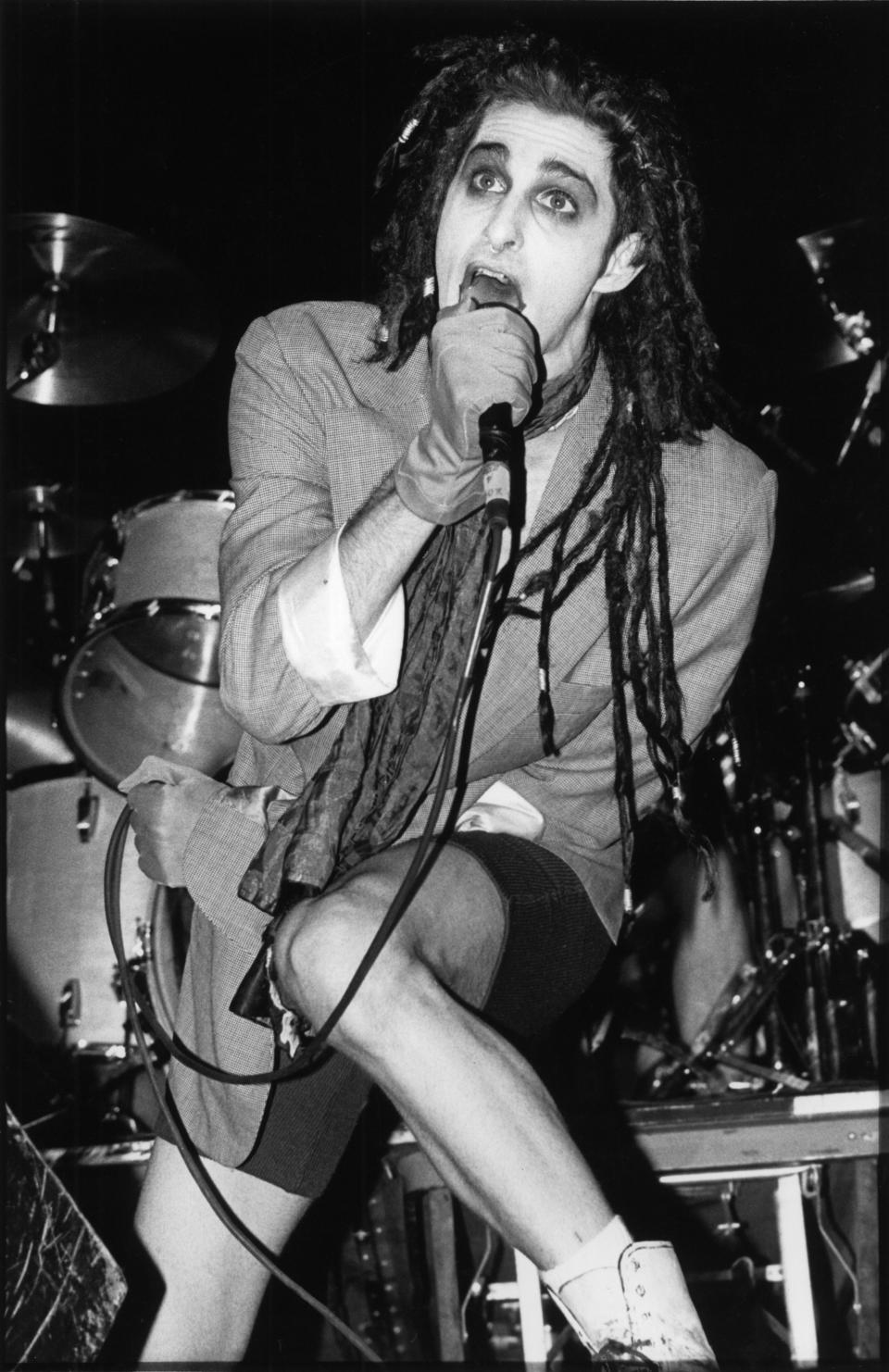
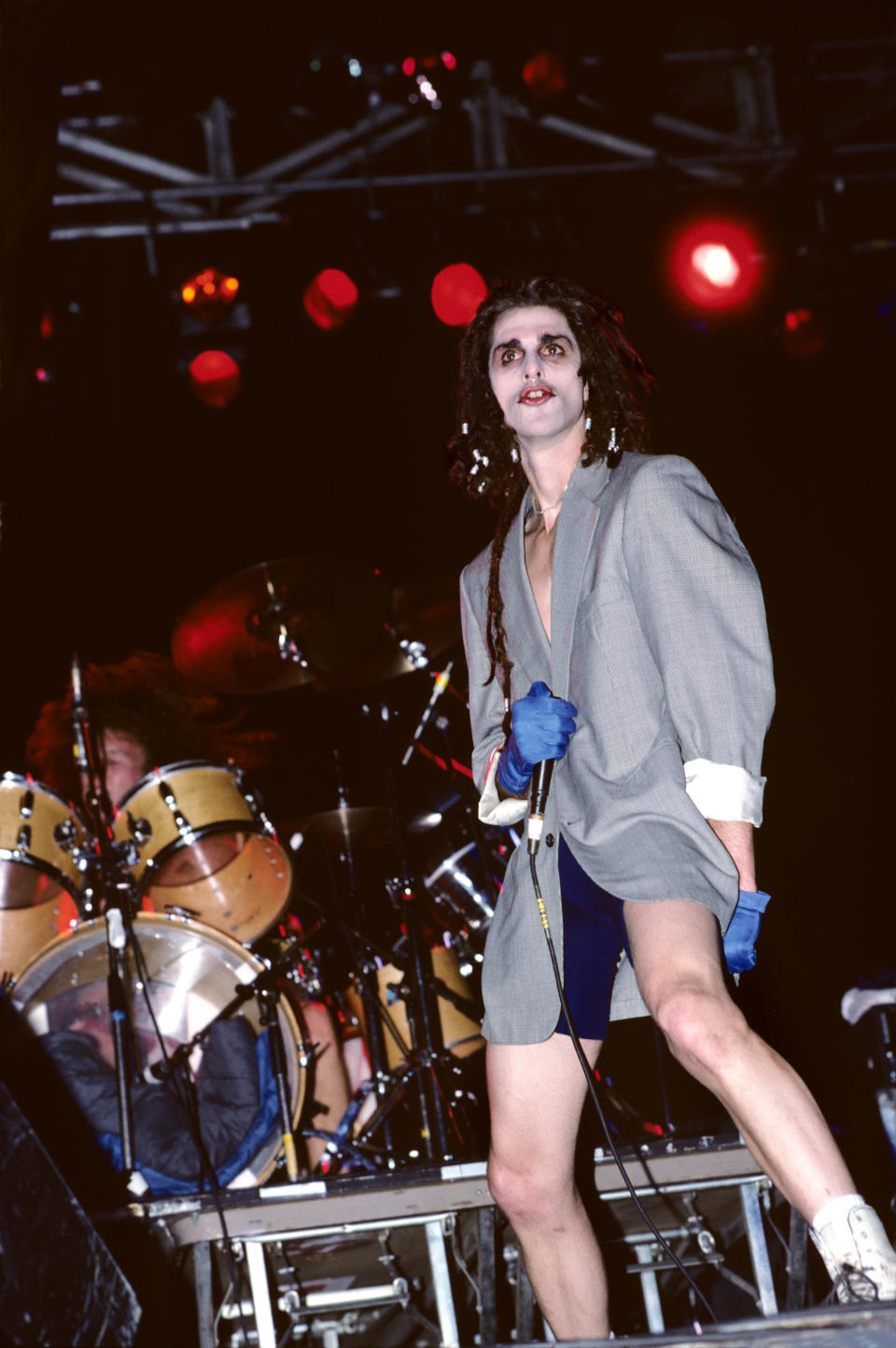
It took a while for Hollywood’s venue bookers to totally catch on. “When Jane’s Addiction first got going, we couldn’t play clubs, and no one would take us,” Navarro recalls. “We had to rent out warehouses and put on events in order to have an opportunity to play. … I mean, we would just play wherever we could set up, and there were gonna be a bunch of freaks that might get into it.
“But that was when we realized that we had the opportunity to try and make our shows a little more theatrical. … Like, ‘Let’s bring some motorcycles in there and some drag queens and have some kind of weird party.’ And sure enough, you know, the thing was slammed. I think that at the time, the venues that were unwilling to hire us — the Roxy, the Whisky, or Doug Weston’s Troubadour — like, we were just too left of what they wanted at the time. So, we just did it ourselves, and I’m super glad that it ended up that way.”

By 1987, however, Jane’s had become popular enough to become the target of a major-label bidding war, and they eventually decided to sign with Warner Bros. Records. Yet, sticking with their rebellious attitude, they insisted on first releasing their eponymous live album on indie label Triple X Records (home to Farrell’s previous band, Psi Com), before going into the studio to record a proper release for Warner. Jane’s Addiction, released in May 1987, was ironically recorded at the Roxy on the Sunset Strip.
Nothing’s Shocking came out a little over a year later. The genre-defying record, co-produced by Dave Jerden (chosen because the band admired Jerden’s engineering work on David Byrne and Brian Eno’s My Life in the Bush of Ghosts) reflected the group members’ wide-ranging musical backgrounds. “There’s elements of all that kind of music that I loved, and to be able to try and bring them all together on one record was a challenge, but it was an exciting challenge,” says Navarro.
Los Angeles gig-goers continued to feel the sea change at a local level after Nothing’s Shocking’s release, when Jane’s Addiction took over Hollywood’s John Anson Ford Amphitheatre for a legendary weeklong run of April 1989 shows that sold out in minutes and featured different handpicked openers every night, including the Buck Pets, the Nymphs, Pigmy Love Circus, and a rising Oklahoma band called the Flaming Lips. (“We dressed up the entire place and just kind of went back to our roots and tried to make it a happening,” says Navarro. “It became kind of an L.A. event that people talked about. … Those nights were fun, because we could let our friends play with us.”) But while Nothing’s Shocking eventually went platinum, in its first year it only shifted about a quarter-million units — modest sales by late-’80s standards.
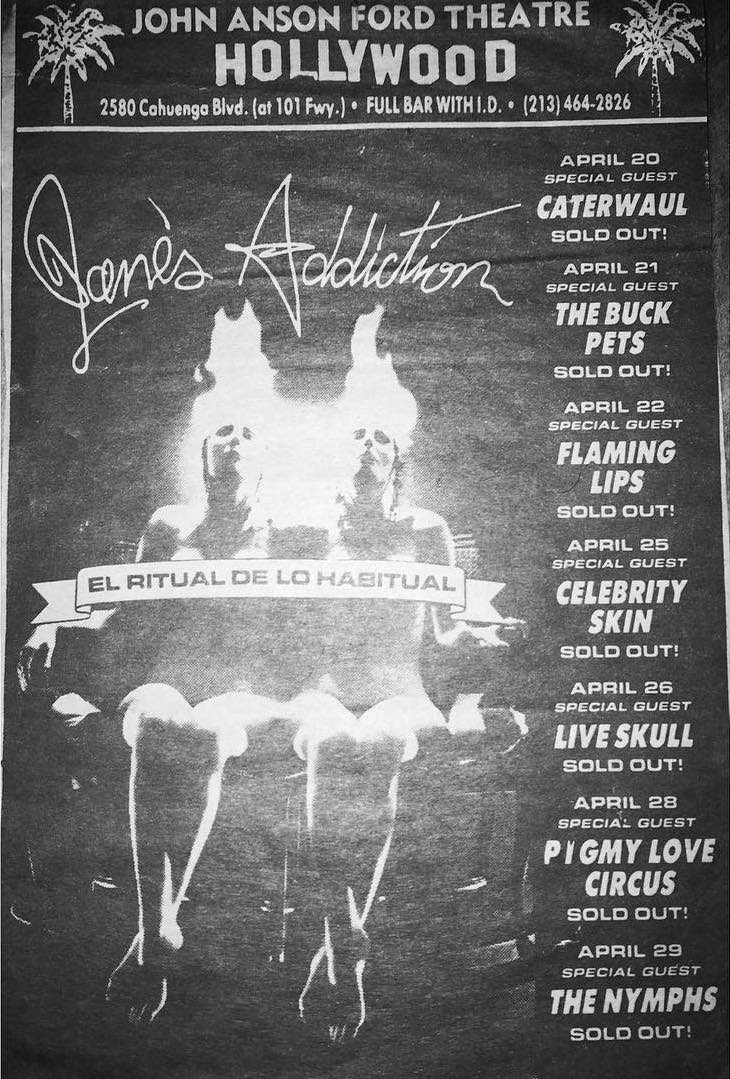
The album’s sales may have been hurt by its cover, which featured Farrell and his then-girlfriend Casey Niccoli’s freaky sculpture of naked, flaming-headed conjoined twins; nine of the 11 biggest U.S. record store chains would stock Nothing’s Shocking only if it was wrapped in brown paper that concealed the potentially offensive image. Navarro says he never understood the outrage.
“You’re talking about four guys that were art fanatics. We spent days off in museums. So certainly a sculpture … any kid of any age can walk into the Louvre and see more nudity than he could possibly imagine,” he shrugs. “With a sculpture of a nude woman on an album cover, we didn’t think twice about that being considered offensive, because art is art. I don’t remember having any particular reaction to it. I don’t think I really gave a f*** if people react negatively to it. It wasn’t like we were staying up late at night going, ‘Oh no, what are we gonna do?’ We were just sort of like, ‘Fine, don’t buy our records.’ I guess evidently people found it shocking, but for us, it was like the statue of David.”
It was Jane’s Addiction’s second Warner Bros. release, 1990’s Ritual de lo Habitual, that would truly break Jane’s nationally and make them MTV darlings. (Farrell’s artwork for that album, which also featured nudity, was replaced in some conservative stores by a “clean” cover printed with stark text of the First Amendment.) However, it wasn’t until 1991 — the same year that Nirvana’s Nevermind came out — that Navarro realized the impact of what he and Jane’s had done.
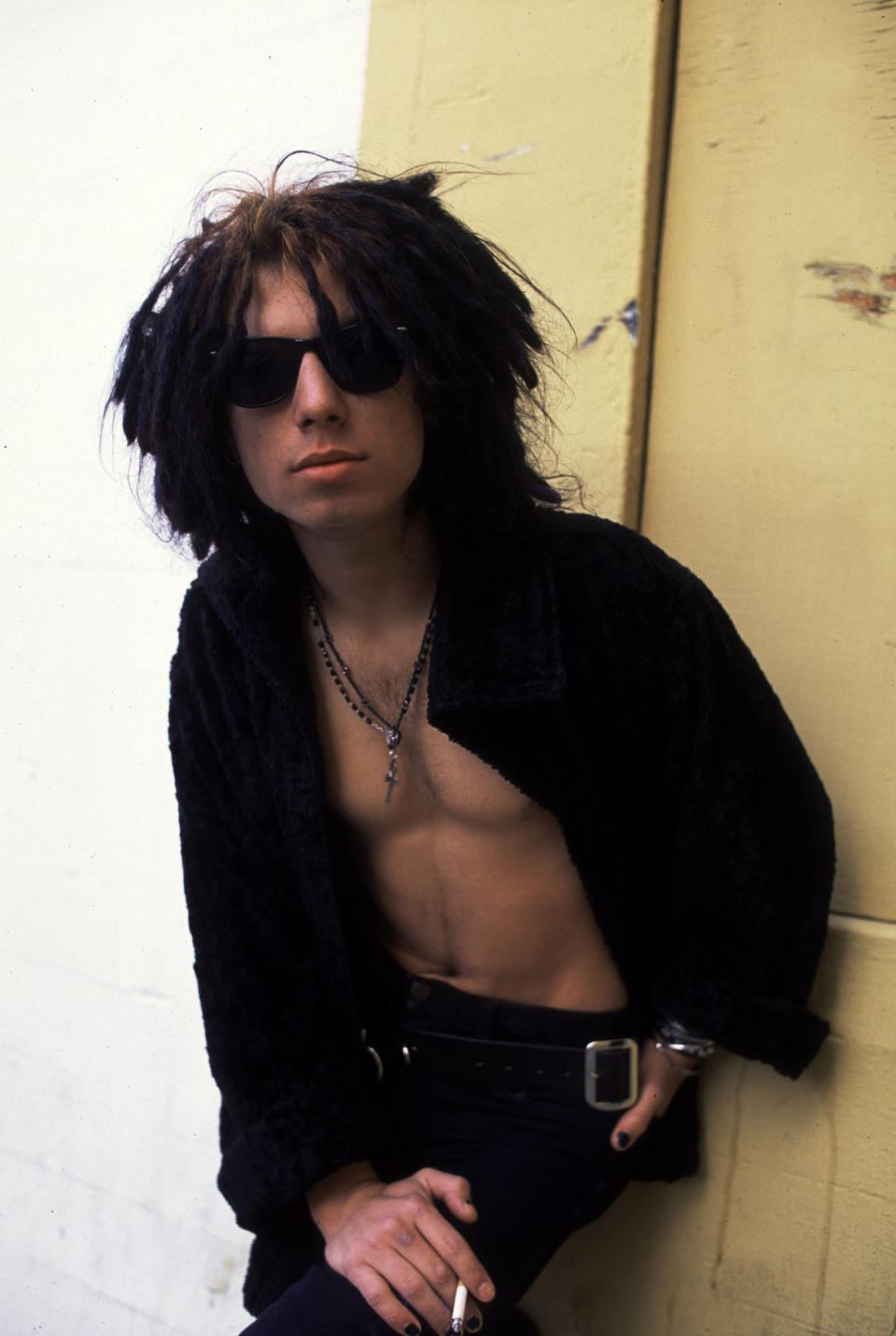
“For me, I think it was at the ’91 Lollapalooza, the very first one,” says Navarro, recalling the inaugural Lollapalooza tour featuring Jane’s Addiction, Siouxsie and the Banshees, Living Colour, Nine Inch Nails, Violent Femmes, Fishbone, Ice-T’s Body Count, Butthole Surfers, Rollins Band, and Lords of Acid. The groundbreaking, Farrell-curated lineup perfectly reflected the eclecticism of Jane’s Addiction themselves. “Perry kind of spearheaded the whole creation and motivation behind it. When we would walk out onstage, night after night after night, the thing would be packed. It kind of sank in, like, ‘Wow, we’re actually making a difference,’” says Navarro.
He adds with a laugh, “And, as with most romantic tales, we went home and broke up! You know what I mean? We were right at our peak!” (Jane’s Addiction reunited in 1997, with the Peppers’ Flea, who’d played trumpet on Nothing’s Shocking, replacing Avery on bass at the time; they played two special shows at the John Anson Ford again, with Chris Chaney on bass, in 2011.)
Farrell tells Yahoo Entertainment that he never regretted disbanding Jane’s just as they were poised to be as massive as Nirvana. “You get into all these petty, petty fights with your group when you're growing up and you're immature. But fame gets thrown on you, and it's almost impossible to handle properly,” he muses. “I feel I left just at the right time. I was in it for the fun, for the excitement, for the art. I don't like pop music, and everything that goes with pop. It bores me. It sucks. It's sellout. It's good if you want to make a lot of money, and that's great if you make a lot of money, but more important to me is the kicks. And more important to me is freedom.”
Contrary to its title, the dark and daring Nothing’s Shocking still shocks, and awes, in 2023. It's definitely not the sound of band that was ever inclined to "sell out." And Navarro seems as shocked as anyone else that the album came out more than three decades ago. “It’s bizarre to be at an age where all these anniversaries of things are coming up — 30-year anniversaries, 25-year anniversaries. It feels like another lifetime.
“It was a strange time for me, because I was just out of high school, was like a metal kid, and I ended up joining this band that was really dangerous, and underground, and street. And, they kind of dabbled in drugs and stuff, and in maybe six months I far surpassed them, in being, I guess quote-unquote, ‘the worst one,’” laughs Navarro, a former “full-blown heroin addict” whose drug exploits and recovery have been well documented. (Navarro hasn’t used drugs intravenously since 2001 and has been completely sober since 2012; he regularly performs shows to support MusiCares and mental health awareness.)
“I honestly can’t believe I’m still alive. It’s one of those surreal experiences,” Navarro marvels. “I mean, I feel like we did that yesterday.”
Portions of these conversations with Navarro, Smith, and McCready are available on demand via the SiriusXM app, on Volume channel 106.

